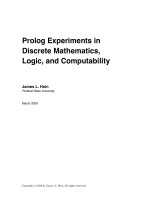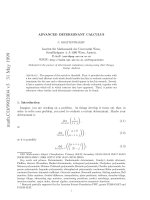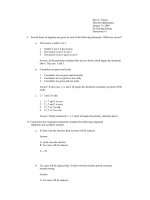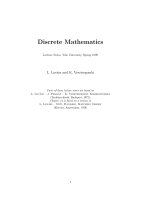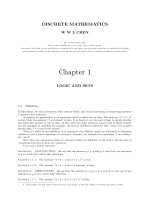Computational discrete mathematics advanced lectures
Bạn đang xem bản rút gọn của tài liệu. Xem và tải ngay bản đầy đủ của tài liệu tại đây (1.31 MB, 179 trang )
Lecture Notes in Computer Science
Edited by G. Goos, J. Hartmanis, and J. van Leeuwen
2122
www.pdfgrip.com
3
Berlin
Heidelberg
New York
Barcelona
Hong Kong
London
Milan
Paris
Tokyo
www.pdfgrip.com
Helmut Alt (Ed.)
Computational
Discrete Mathematics
Advanced Lectures
13
www.pdfgrip.com
Series Editors
Gerhard Goos, Karlsruhe University, Germany
Juris Hartmanis, Cornell University, NY, USA
Jan van Leeuwen, Utrecht University, The Netherlands
Volume Editor
Helmut Alt
Freie Universităat Berlin, Institut făur Informatik
Takustr. 9, 14195 Berlin, Germany
E-mail:
Cataloging-in-Publication Data applied for
Die Deutsche Bibliothek - CIP-Einheitsaufnahme
Computational discrete mathematics : advanced lectures / Helmut Alt (ed.). Berlin ; Heidelberg ; New York ; Barcelona ; Hong Kong ; London ; Milan ;
Paris ; Tokyo : Springer, 2001
(Lecture notes in computer science ; 2122)
ISBN 3-540-42775-9
CR Subject ClassiÞcation (1998):F.2, G.2, I.3.5
ISSN 0302-9743
ISBN 3-540-42775-9 Springer-Verlag Berlin Heidelberg New York
This work is subject to copyright. All rights are reserved, whether the whole or part of the material is
concerned, speciÞcally the rights of translation, reprinting, re-use of illustrations, recitation, broadcasting,
reproduction on microÞlms or in any other way, and storage in data banks. Duplication of this publication
or parts thereof is permitted only under the provisions of the German Copyright Law of September 9, 1965,
in its current version, and permission for use must always be obtained from Springer-Verlag. Violations are
liable for prosecution under the German Copyright Law.
Springer-Verlag Berlin Heidelberg New York
a member of BertelsmannSpringer Science+Business Media GmbH
© Springer-Verlag Berlin Heidelberg 2001
Printed in Germany
Typesetting: Camera-ready by author, data conversion by Olgun ComputergraÞk
Printed on acid-free paper
SPIN 10839914
06/3142
543210
www.pdfgrip.com
Preface
In order to speed up doctoral education in Germany the “Deutsche Forschungsgemeinschaft” (DFG, German Research Association) in the late 1980s developed a new funding concept for graduate programs called “Graduiertenkollegs”.
Groups of university teachers could join together and submit proposals for doctoral studies within certain areas of research. If funded, the program would
supply scholarships for doctoral students including means for travel, literature,
scientific guests, meetings, and schools. The scholarships would allow doctorands
to concentrate on their doctoral studies without the usual teaching duties and
to obtain their degree in a much shorter period of time.
It was the idea of Martin Aigner to join efforts of mathematicians and computer scientists in the newly reunified Berlin and to apply for a graduate program
within discrete mathematics and theoretical computer science. The final proposal
was submitted by researchers from the three universities of Berlin, Free University, Humboldt-University, and Technical University, and the then still existing
Academy of Sciences of the German Democratic Republic. The specific areas
covered were geometric pattern recognition, constructive approximation, complexity theory, combinatorial optimization, graph theory, computational combinatorics, coding theory, and group theory. The proposal was accepted by the
DFG, the program was named “Algorithmische Diskrete Mathematik” (Computational Discrete Mathematics), and Emo Welzl was elected as its first speaker.
The program started with the first four doctorands on October 1st, 1991.
The program was extended twice by the DFG and ended in September 2000
after the maximal possible runtime of nine years. Twenty-five of the students
funded obtained their doctoral degree, most of them within a time period significantly below average and many of them even within the standard two and a half
years of funding by the program. All in all during the last years, discrete mathematics and algorithmics in general have been flourishing within Berlin mainly
due to the existence of the graduate program.
In order to enhance contact and cooperation between the various research
areas of the members of the program it had been decided at the beginning that
there should be a weekly meeting on Monday afternoons during semesters. Part
of this meeting consists of a 60 to 90 minute tutorial lecture by faculty members
of the program or selected guests. These lectures should be understandable not
only to specialists but to all members of research groups involved in the program.
Still, they should be at a high scientific level including recent research results
within the different fields of the program. They have turned out to be very
popular and very fruitful for all groups involved including the faculty members
of the program who use the opportunity to learn about the research areas of
their colleagues. In order to make the material of these lectures available to a
larger public we created this booklet containing twelve selected lectures held
within the graduate program. It covers the whole range of areas represented
www.pdfgrip.com
VI
Preface
in the program including combinatorics, graph theory, coding theory, discrete
and computational geometry, optimization, and algorithmic aspects of algebra.
Particularly intriguing are the nonobvious connections between different areas
such as combinatorics, linear algebra, discrete geometry, and graph theory in the
contribution by Martin Aigner; algebraic computing and graph theory in the one
by Gă
unter Rote; or discrete geometry, graph theory, and coding theory in the
one by Gă
unter M. Ziegler.
A preliminary version of this booklet was published internally on the day
of celebration of the end of the old graduate program and the start of a new
one called “Combinatorics, Geometry, and Computation” which is a European
graduate program of the same research groups together with partners at ETH
Zurich and other European institutions.
Berlin, June 1, 2001
Helmut Alt
www.pdfgrip.com
Table of Contents
Lattice Paths and Determinants . . . . . . . . . . . . . . . . . . . . . . . . . . . . . . . . . . . . .
Martin Aigner (Freie Universită
at Berlin)
1
The Nearest Neighbor . . . . . . . . . . . . . . . . . . . . . . . . . . . . . . . . . . . . . . . . . . . . . . 13
Helmut Alt (Freie Universită
at Berlin)
Explicit and Implicit Enforcing – Randomized Optimization . . . . . . . . . . . . . 25
Bernd Gă
artner and Emo Welzl (ETH Ză
urich)
Codes over Z4 . . . . . . . . . . . . . . . . . . . . . . . . . . . . . . . . . . . . . . . . . . . . . . . . . . . . . 47
Tor Helleseth (University of Bergen)
Degree Bounds for Long Paths and Cycles in k-connected Graphs . . . . . . . . 56
Heinz Adolf Jung (Technische Universită
at Berlin)
Data Structures for Boolean Functions . . . . . . . . . . . . . . . . . . . . . . . . . . . . . . . . 61
Christoph Meinel and Christian Stangier (Universită
at Trier)
Scheduling under Uncertainty: Bounding the Makespan Distribution . . . . . . 79
Rolf H. Mă
ohring (Technische Universită
at Berlin)
Random Graphs, Random Triangle-Free Graphs,
and Random Partial Orders . . . . . . . . . . . . . . . . . . . . . . . . . . . . . . . . . . . . . . . . . 98
Hans Jă
urgen Pră
omel and Anusch Taraz
(HumboldtUniversită
at zu Berlin)
Division-Free Algorithms for the Determinant and the Pfaffian:
Algebraic and Combinatorial Approaches . . . . . . . . . . . . . . . . . . . . . . . . . . . . . 119
Gă
unter Rote (Freie Universită
at Berlin)
Check Character Systems and Anti–symmetric Mappings . . . . . . . . . . . . . . . 136
Ralph-Hardo Schulz (Freie Universită
at Berlin)
Algorithms in Pure Mathematics . . . . . . . . . . . . . . . . . . . . . . . . . . . . . . . . . . . . . 148
Gernot Stroth (Martin-Luther-Universită
at Halle Wittenberg)
Coloring Hamming Graphs, Optimal Binary Codes,
and the 0/1-Borsuk Problem in Low Dimensions . . . . . . . . . . . . . . . . . . . . . . . 159
Gă
unter M. Ziegler (Technische Universită
at Berlin)
Author Index . . . . . . . . . . . . . . . . . . . . . . . . . . . . . . . . . . . . . . . . . . . . . . . . . 173
www.pdfgrip.com
Author Index
Aigner, Martin 1
Alt, Helmut 13
Gă
artner, Bernd
Helleseth, Tor
Rote, Gă
unter
Schulz, Ralph-Hardo 136
Stangier, Christian 61
Stroth, Gernot 148
25
47
Jung, Heinz Adolf
56
Meinel, Christoph
Mă
ohring, Rolf H.
61
79
Pră
omel, Hans Jă
urgen
119
Taraz, Anusch
Welzl, Emo
98
98
25
Ziegler, Gă
unter M.
159
www.pdfgrip.com
Lattice Paths and Determinants
Martin Aigner
Department of Mathematics and Computer Science, Free University of Berlin
Arnimallee 3, 14195 Berlin, Germany
The essence of mathematics is proving theorems – and so, that is what mathematicians do: they prove theorems. But to tell the truth, what they really want
to prove once in their lifetime, is a Lemma, like the one by Fatou in analysis,
the Lemma of Gauss in number theory, or the Burnside-Frobenius Lemma in
combinatorics.
Now what makes a mathematical statement a true Lemma? First, it should
be applicable to a wide variety of instances, even seemingly unrelated problems.
Secondly, the statement should, once you have seen it, be completely obvious.
The reaction of the reader might well be one of faint envy: Why haven’t I noticed
this before? And thirdly, on an esthetic level, the Lemma including its proof
should be beautiful!
In this article we look at one such marvellous piece of mathematical reasoning, the Lemma of Gessel and Viennot which has become an instant classic in
combinatorial enumeration since its appearance in 1985 [1]. A similar version
which was largely overlooked was previously obtained by Lindstrăom [2].
1
Four Problems
Let us consider the following four problems which do not appear to have much
in common – and yet they can all be solved by the Gessel–Viennot Lemma.
A. The following curious problem was posed by Berlekamp and answered by
Carlitz, Roselle and Scoville, see [4], p. 231. Suppose we are given a Young
diagram D corresponding to the partition λ : n1 n2 . . . nt , n1 ≥ n2 ≥ . . . ≥ nt .
Given a square s of D, let be the lowest square in the same column as s, and
r the rightmost square in the same row as s. Insert into s the number f (s) of
paths from to r which stay inside D and use steps to the north and east only.
Figure 1 shows the diagram of λ : 765532 and the numbers f (s). Consider
the largest square matrix M contained in D. In the figure, the 4 × 4–matrix is
drawn with bold lines.
Problem. Prove that always det M = 1.
B. Everybody knows the Catalan numbers Cn , defined by the convolution
recursion
n
C0 = 1, Cn+1 =
Ck Cn−k (n ≥ 0).
k=0
H. Alt (Ed.): Computational Discrete Mathematics, LNCS 2122, pp. 1–12, 2001.
c Springer-Verlag Berlin Heidelberg 2001
www.pdfgrip.com
2
Martin Aigner
142 46
16
7
2
1
47
16
6
3
1
1
19
7
3
2
1
5
2
1
1
1
2
1
1
1
1
1
Fig. 1.
Stanley lists in his admirable book [4] some 70 combinatorial instances which
are counted by the Catalan numbers. One of the classical examples are Dyck
paths of length 2n. These are lattice paths from (0, 0) to (2n, 0) which never go
below the line y = 0 and use only diagonal steps north–east or south–east. The
number of these Dyck paths (of length 2n) is precisely Cn .
The next figure shows the C3 = 5 Dyck paths of length 6:
Fig. 2.
One of the most elegant characterizations of the sequence (Cn ) goes as follows: Associate to (Cn ) the Hankel matrices Hn and Hn (n ≥ 0), where
C0 C1 . . . Cn
C1 C2 . . . Cn+1
C1 C2 . . . Cn+1
C2 C3 . . . Cn+2
Hn =
, Hn =
.
.
.
.
.
.
.
Cn Cn+1 . . . C2n
Cn+1 Cn+2 . . . C2n+1
Of course, we may associate such a pair of Hankel matrices to any sequence
of real numbers.
Problem. Prove that (Cn ) is the unique sequence of real numbers such that
det Hn = det Hn = 1 f or all n ≥ 0.
C. The Stirling numbers of the second kind Sn,k are defined as the number of
partitions of an n-set into k blocks. A classical result states that the numbers
Sn,k satisfy the recursion
www.pdfgrip.com
Lattice Paths and Determinants
3
S0,0 = 1, S0,k = 0 (k > 0)
Sn,k = Sn−1,k−1 + kSn−1,k (n ≥ 1).
Problem. Prove that for any m ≥ 0, n ≥ 1 :
Sm+1,1 Sm+1,2 . . . Sm+1,n
Sm+2,1 Sm+2,2 . . . Sm+2,n
det
= (n!)m .
.
.
.
Sm+n,1 Sm+n,2 . . . Sm+n,n
D. A particularly appealing counting result (due to Mac Mahon [3]) concerns
the enumeration of rhombic tilings of a regular hexagon of side length n. Consider
the hexagon in figure 3 (of side length 3) and triangulate it. A rhombus consists
of two triangles with a common side, and what we are interested in is the total
number h(n) of partitions (tilings) of the hexagon into rhombi.
Fig. 3. A hexagon of length 3 and a rhombic tiling.
The figure on the right shows one possible tiling. One easily computes h(1) =
2, h(2) = 20. But already the case n = 3 becomes quite difficult to do by hand
(in fact, h(3) = 980).
Problem. Find a formula for h(n).
2
The Lemma of Gessel and Viennot
The starting point is the usual permutation representation of the determinant
of a matrix. Let M = (mij ) be a real n × n–matrix. Then
det M =
(sign σ)m1σ(1) m2σ(2) . . . mnσ(n) ,
σ
(1)
www.pdfgrip.com
4
Martin Aigner
where σ runs through all permutations of {1, 2, . . . , n}, and the sign of σ is
1 or −1 depending on whether σ is the product of an even or odd number of
transpositions.
Now we pass to graphs, more precisely to weighted directed bipartite graphs.
Let the vertices A1 , . . . , An stand for the rows of M , and B1 , . . . , Bn for the
columns. For all i and j draw an arrow from Ai to Bj and give it the weight mij
as in the figure:
A1
❝
...
m11 ❄
❝
Ai
❝
❆
An
❝
mnj
mij❆
mnn
✠
❄
❆
... ❝
❆ ❝
...
...
B1
Bj
Bn
Fig. 4.
In terms of the graph, formula (1) has the following interpretation:
– The left-hand side is the determinant of the path–matrix M where the (i, j)entry of M is the weight of the (unique) path from Ai to Bj .
– The right-hand side is the weighted (signed) sum over all vertex-disjoint path
systems from A = {A1 , . . . , An } to B = {B1 , . . . , Bn }. Such a system Pσ is
given by paths
Pσ : A1 → Bσ(1) , . . . , An → Bσ(n) ,
and the weight of Pσ is the product of the weights of the individual paths:
w(Pσ ) = w(A1 → Bσ(1) ) · · · w(An → Bσ(n) ).
In this interpretation formula (1) reads
(sign σ)w(Pσ ).
det M =
σ
And what is the result of Gessel and Viennot? It is the natural generalization of
(1) from bipartite to arbitrary weighted directed graphs. It is precisely this step
to arbitrary graphs that makes the Lemma so widely applicable – and what’s
more, the proof is stupendously simple and elegant.
Let us first collect the necessary concepts. We are given a finite acyclic directed graph G = (V, E). In particular, there are only finitely many directed
paths between any two vertices A and B, where we include all trivial paths
A → A of length 0. Every edge e carries a real weight w(e). If P is a directed
path from A to B, written shortly P : A → B, then we define the weight of P
as
w(P ) =
e∈P
w(e)
w(P ) = 1 if P has length 0 .
www.pdfgrip.com
Lattice Paths and Determinants
5
Now let A = {A1 , . . . , An } and B = {B1 , . . . , Bn } be two sets of n vertices,
where A and B need not be disjoint. To A and B we associate the path matrix
M = (mij ) with
mij =
w(P ) .
P :Ai →Bj
A path system P from A to B consists of a permutation σ together with n paths
Pi : Ai → Bσ(i) (i = 1, . . . , n); we write sign P = sign σ. The weight of P is the
product of the path weights
n
w(P) =
w(Pi ) .
(2)
i=1
Finally, we say that the path system P = (P1 , . . . , Pn ) is vertex-disjoint if the
paths of P are pairwise vertex-disjoint.
LEMMA. Let G = (V, E) be a finite acyclic weighted directed graph, A =
{A1 , . . . , An } and B = {B1 , . . . , Bn } two n-sets of vertices, and M the path
matrix from A to B. Then
(sign P)w(P) .
det M =
(3)
P vertex −disjoint
Proof. A typical summand of det M is
(sign σ)m1σ(1) · · · mnσ(n) =
(sign σ)
w(P1 ) · · ·
P1 :A1 →Bσ(1)
w(Pn ) .
Pn :An →Bσ(n)
Summing over σ we immediately find from (2) that
det M =
(sign P)w(P) ,
P
where P runs through all path systems from A to B (vertex-disjoint or not).
Hence to arrive at (3), all we have to show is
(sign P)w(P) = 0 ,
(4)
P∈N
where N is the set of all path systems that are not vertex-disjoint. And this is accomplished by an argument of singular beauty. Namely, we exhibit an involution
π : N → N (without fixed points) such that for P and πP
w(πP) = w(P) and sign (πP) = −sign P.
Clearly, this will imply (4) and thus formula (3).
The involution π is defined in the most natural way. Let P ∈ N with paths
Pi : Ai → Bσ(i) . By definition, some pair of paths will intersect:
www.pdfgrip.com
6
Martin Aigner
– Let i0 be the minimal index such that Pi0 shares some vertex with another
path.
– Let X be the first such common vertex on the path Pi0 .
– Let j0 (> i0 ) be the minimal index such that Pj0 has the vertex X in common
with Pi0 .
The figure shows the situation:
Bσ(j0 )
Ai 0
Bσ(i0 )
X
Aj0
Fig. 5.
Now we construct the new system πP = (P1 , . . . , Pn ) as follows:
– Pk = Pk for all k = i0 , j0 ,
– the new path Pi0 goes from Ai0 to X along Pi0 , and then continues to Bσ(j0 )
along Pj0 . Similarly, Pj0 goes from Aj0 to X along Pj0 and continues to
Bσ(i0 ) along Pi0 .
Clearly π(πP) = P, since the index i0 , the vertex X, and the index j0 are
the same as before. In other words, applying π twice we switch back to the
old paths Pi . Next, since πP and P use precisely the same edges, we certainly
have w(πP) = w(P). And finally, since the new permutation σ is obtained by
multiplying σ with the transposition (i0 , j0 ), we find sign (πP) = −sign P, and
that’s it.
3
A Graphical Approach to Determinants
Before going on to the problems, let us see how the Lemma of Gessel-Viennot
can be used to derive all basic properties of determinants, just by looking at
appropriate graphs. We consider four examples.
1. det M T = det M.
Just look at figure 4 from bottom up. In other words, we reverse all arrows. Since
sign σ −1 = sign σ, the result follows.
2. If the rows A1 , . . . , An of M are linearly dependent, then det M = 0.
Suppose An = λ1 A1 + · · · + λn−1 An−1 , then the following graph has M as path
matrix from A to B: Put An on top with an arrow of weight λi leading to Ai for
all i, and keep the rest.
www.pdfgrip.com
Lattice Paths and Determinants
7
An
❝
◗◗
❄
λ1 ✠
λi ◗s
◗λn−1
◗
A1
◗ ❝An−1
... ◗
❝ . . . ❝Ai
❆
m11 ❄
mij❆
mnn
❄
❆
❆❝
...
... ❝
❝
B1
Bj
Bn
Fig. 6.
Since in this graph there is no vertex-disjoint path system from A to B at
all, we infer det M = 0 from (3).
3. det(M M ) = (det M ) (det M ).
Let the bipartite graph on A and B correspond to M as in figure 4, and similarly
the bipartite graph on B and C to M . Consider now the concatenated graph as
mik mkj , we find that the path matrix from A
in figure 7. Since (M M )ij =
k
to C is precisely the product M M .
A1
❝
Ai
❝
✑❆
...
An
❝
...
✑
mi1 ✑
✰
❆ mij
❆
✑
❆
✑
.
.
.
❝
B1
Bj ❝
❅
❅
mjk
m1k❅
❘
✠
❅
. . . ❅ ❝
...
❝
✑
✑
C1
Ck
...
❝Bn
❝
Cn
Fig. 7.
As the vertex-disjoint path systems from A to C in the concatenated graph
correspond to pairs of systems from A to B resp. from B to C, the result follows
immediately from the Lemma, noting that sign (στ ) = (sign σ)(sign τ ).
4. Formula of Binet-Cauchy
A very useful generalization of the product rule is a result named after Binet
and Cauchy. Let M be a n × p–matrix and M a p × n–matrix, n ≤ p. Then
(det MZ )(det MZ ) ,
det(M M ) =
Z
www.pdfgrip.com
8
Martin Aigner
where MZ is the n × n–submatrix of M with columns Z, and MZ the submatrix
of M with the corresponding rows Z.
The proof proceeds as in 3) by looking at the corresponding concatenated
graph.
4
Solving the Problems
One of the nicest features of the Lemma is the fact that formula (3) can be read
in two ways. It gives a method to compute a determinant if we can evaluate the
sum on the right-hand side of (3). But it can also be used to solve an enumeration
problem (interpreted as the right-hand side of (3)) if we can somehow calculate
the determinant on the left. Problems A), B) and C) will illustrate the first
aspect, and problem D) the second.
A. Let D be the Young diagram of λ : n1 n2 . . . nt . We construct a directed
graph GD as follows:
The vertices are the squares of D, and we draw an edge (of weight 1) between
any two neighbouring squares in the direction north or east. Suppose the largest
square array contained in D has size n × n. Then we take A1 , . . . , An to be the
bottom squares of columns 1, . . . , n, and B1 , . . . , Bn the rightmost squares of
rows 1, . . . , n.
As an illustration, the graph GD corresponding to the diagram in figure 1
looks as follows:
q✲ q✲ q✲ q✲ q✲ q✲ q B
1
✲ q✻
✲ q✻
✲ q✻
✲ q✻
✲ q✻
q✻
B2
✻
q✲ ✻
qB
q✲ ✻
q✲ ✻
q✲ ✻
3
✻
q✲ ✻
qB
q✲ ✻
q✲ ✻
q✲ ✻
✲ q✻
✲ q✻
q✻
✻
q✲ ✻
q
A1
A4
4
A3
A2
Fig. 8.
Since all weights are equal to 1, the matrix M (filled with the numbers f (s))
is clearly the path matrix from A to B, so to apply the Lemma, we have to find
all vertex-disjoint path systems from A to B. But a moment’s thought should
convince the reader that there is only one such system, connecting Ai with
Bi (i = 1, . . . , n) in “hooks”. (They are drawn with bold lines in the figure.) As
sign(id) = 1 and w(P) = 1, we obtain det M = 1 as claimed.
www.pdfgrip.com
Lattice Paths and Determinants
9
B.
Note first that the sequence of determinants det H0 , det H0 , det H1 ,
det H1 , . . . uniquely determines the original sequence provided that det Hn = 0,
det Hn = 0 for all n. Hence if we can show det Hn = det Hn = 1 for the Catalan
numbers Cn , then (Cn ) will indeed be the only sequence with this property.
However, det Hn = 1 resp. det Hn = 1 for the Catalan numbers is just
˜ :
the special case of A) applied to the partitions λ : 2n + 1, 2n, . . . , 1 resp. λ
2n + 2, 2n + 1, . . . , 1. The figure shows these graphs for n = 2 (with the arrows
omitted):
q
q
q
q
q B2
q
q
q
q
q
q B2
q
q
q
q
q
q
q
q
q B1
q
A0 = B0
A1
q
q
q
q
q
q
q
q B0
q
q
q
A2
q
q
q B1
q
A0
A1
A2
Fig. 9.
Tilting the Dyck paths in figure 2 by 45 degrees, it should be clear that, in
general, the paths from Ai to Bj in figure 9 are just the Dyck paths of length
2(i + j) resp. 2(i + j + 1). Hence the path matrices are precisely Hn = (Ci+j )
resp. Hn = (Ci+j+1 ), and the assertion follows from A).
C. Take the Stirling table (Sn,k ) and turn it counterclockwise by 90◦ . That is,
Sn,k is placed at the point (n, k). The recursion
Sn,k = Sn−1,k−1 + kSn−1,k
tells us the following. Consider the directed graph in the upper half plane y ≥ 0,
with edges going diagonally up (north-east) with weight 1 and horizontally (east)
with weight k if the horizontal step occurs at y = k. Then Sn,k is the sum of all
weighted paths from (0, 0) to (n, k).
The figure shows n = 5, k = 3 with S5,3 = 25.
q
q
q (5, 3)
3 3
q q q
2 2
q
q
q
1 1
q
q
q
(0, 0)
0
0
Fig. 10.
There are 6 non–zero paths from (0, 0) to (5, 3) with weights 1, 2, 3, 4, 6 and 9,
summing to 25.
www.pdfgrip.com
10
Martin Aigner
Hence to compute the determinant in problem C) we use the following set-up:
q
...
qB
q
q
q
q
q
q q q
...
qB
...
qB
...
qB
n
An
...
A3
A2
A1
3
2
1
q
m+1
Fig. 11.
Defining the steps and weights as before we find that the sum of the weighted
paths from Ai to Bj is precisely Sm+i,j (1 ≤ i, j ≤ n). Hence the matrix of
Stirling numbers is precisely the path matrix M of the graph in figure 11. And
what are the vertex-disjoint path systems? Again there is only one, connecting
Ai to Bi (i = 1, . . . , n) as in the figure. The diagonal weights are all 1, and of the
horizontal steps there are m at every level y = k (k = 1, ..., n). So we conclude
from the Lemma
det M = 1m 2m · · · nm = (n!)m .
D. Take a triangulated hexagon of side length n and associate to it the directed
graph G as in figure 12 with all edges going up and all weights equal to 1.
B2
A2
A1
A0
Fig. 12.
B1
B0
www.pdfgrip.com
Lattice Paths and Determinants
11
Let A be the vertices A0 , A1 , . . . , An−1 at the bottom and B = {B0 , . . . ,
Bn−1 } those on top. It should be clear from the figure that any vertex-disjoint
path system P from A to B must join Ai with Bi for all i, that is sign P = 1 for
all P.
Here is the key observation: The rhombic tilings are in one-to-one correspondence with the vertex-disjoint path systems from A to B. To see this, look at a
rhombic tiling in a “3-dimensional” fashion, as suggested by figure 13.
ắ
ẵ
ẳ
ắ
ẵ
ẳ
Fig. 13.
We shade all tiles of shape
. Climbing up the “white ladders” yields a
vertex-disjoint path system in G from A to B. Conversely, it is readily seen that
any such system in G gives a tiling by adjoining “white” tiles according to the
paths, and filling in the rest with shaded tiles.
So, what we have proved is that for this directed graph G
w(P ) = h(n).
P vertex −disjoint
To apply the Lemma it remains to compute the number mij of paths in G from
Ai to Bj , and then to evaluate det M .
Now a moment’s reflection shows that mij really counts paths in a square
grid (look at figure 12), and we find
mij =
2n
n+i−j
(0 ≤ i, j ≤ n − 1) .
www.pdfgrip.com
12
Martin Aigner
From this, the determinant of M = (mij ) is easily evaluated, yielding the following beautiful formula of Mac Mahon:
n−1
h(n) =
i=0
2n+i
n
n+i
n
.
As examples, we obtain again h(1) = 2, h(2) = 20, h(3) = 980, and as next
value h(4) = 232848.
References
1. I. M. Gessel, G. Viennot: Binomial determinants, paths, and hook length formulae.
Advances in Math. 58 (1985), 300321.
2. B. Lindstră
om: On the vector representation of induced matroids. Bull. London
Math. Soc. 5 (1973), 85–90.
3. P. A. Mac Mahon: Combinatory Analysis, Vol. 2. Chelsea 1960.
4. R. P. Stanley: Enumerative Combinatorics, Vol. 2. Cambridge Univ. Press 1999.
www.pdfgrip.com
The Nearest Neighbor
Helmut Alt
Department of Mathematics and Computer Science, Free University of Berlin,
Takustr.9, 14195 Berlin, Germany
1
The Problem
The nearest neighbor problem is defined as follows:
Given a metric space X and a fixed finite subset S ⊂ X of n “sites”,
preprocess S and build a data structure so that queries of the following
kind can be answered efficiently: Given a point q ∈ X find one of the
points p ∈ S closest to q (see Figure 1).
Ô
Õ
Fig. 1. The nearest-neighbor problem in the plane with Euclidean distance
Clearly, the question whether this problem can be solved efficiently, depends on
the underlying metric space, here we will consider the d-dimensional real space
Rd usually together with the 1 , ∞ , or the 2 (Euclidean) metric. The criteria
for the efficiency of a solution are the preprocessing time to construct the data
structure, its storage requirements, and, in particular, the query time. Since
preprocessing needs to be done only once, storage and query time are usually
the more important criteria.
H. Alt (Ed.): Computational Discrete Mathematics, LNCS 2122, pp. 13–24, 2001.
c Springer-Verlag Berlin Heidelberg 2001
www.pdfgrip.com
14
Helmut Alt
The nearest neighbor problem is a very natural problem in computational
geometry and, therefore, interesting by itself. Originally, it was formulated by
Minsky and Papert [24] and its two-dimensional version was posed in 1972 by
McNutt in the context of finding the nearest post office from some given location
q. Knuth [20] describes McNutt’s data structure, the post-office tree, and since
then the problem is also known as the post-office-problem.
The nearest-neighbor problem also has numerous applications. In fact, nearest neighbor methods are being used in statistics and data analysis [6] information retrieval [27], data compression [12], pattern recognition [8] and multimedia
databases [26].
2
The Voronoi-Diagram Approach
The structure in computational geometry that is most closely related to nearestneighbor or other “proximity” problems is the Voronoi-diagram (for a survey
see [3], [25]).
For a given set S ⊂ Rd the Voronoi-diagram V D(S) is a partitioning of Rd
assigning to each site p ∈ S its Voronoi region consisting of those points x ∈ Rd
that are closer to p than to any other point in S. The Euclidean distance Voronoi
diagram in two dimensions (see Figure 2) is well studied and understood. It has
the following properties:
1. The Voronoi regions are convex and bounded by line segments or rays, which
are called Voronoi-edges.
2. Each Voronoi edge is a connected segment of the bisector between two points
p, q ∈ S i.e. the straight line consisting of all points equally close to p and q.
3. The endpoints of the Voronoi edges are called Voronoi vertices. Each of
them has at least three closest points in S, and, therefore is the center of the
circumcircle of these points.
4. The Voronoi diagram can be considered as an embedded planar graph with
n faces (adding an artificial Voronoi vertex “at infinity” which is an endpoint
of all unbounded edges). It can be derived from Euler’s formula for planar
graphs that the number of edges is at most 3n−6 and the number of vertices
at most 2n − 5. So alltogether, the Voronoi diagram has a complexity linear
in the number of sites.
5. The Voronoi diagram can be constructed in O(n log n) time. Various algorithms for this purpose have been found, for example a divide-and-conquer
approach, a randomized incremental construction, a sweepline technique,
and a reduction to computing convex hulls of finite sets of points in three
dimensions (see e.g. [25], [18], [4]).
Clearly, once the Voronoi diagram of S has been computed, the nearest-neighbor
problem reduces to a point location of the query point q within V D(S), i.e.
finding the Voronoi cell that contains q.
A very simple point location data structure that was already described in
one of the first papers on nearest neighbors by Dobkin and Lipton [7] can be
constructed as follows:
www.pdfgrip.com
The Nearest Neighbor
15
Õ
Fig. 2. A two-dimensional Euclidean distance Voronoi-diagram
Suppose (without loss of generality) that no Voronoi edges are vertical.
Project all Voronoi vertices to the x-axis yielding O(n) real intervals
(−∞, x1 ] , [x1 , x2 ] . . . [xm , +∞)
(see Figure 3). If we consider the vertical straight lines through all xi , i =
1, . . . , m we obtain a partition of the plane into vertical “slabs”. Each slab is
subdivided into triangular or trapezoidal cells by the sequence of Voronoi-edges
that cross it. For each slab we store this sequence ordered from bottom to top
together with the information for each cell to which Voronoi region it belongs.
With this data structure a point location and thus a nearest neighbor query
can be performed as follows:
– given the query point q, do a binary search of its x-coordinate within the
intervals of the x-axis, to obtain the slab containing q.
– Within this slab, do a binary search on the ordered sequence of Voronoi
edges to obtain the cell containing q. Then we also have the Voronoi region
containing q and, thus, its nearest neighbor.
Since the processing of the query essentially consists of two binary searches
on structures whose size is linear in n the query time is O(log n).
www.pdfgrip.com
16
Helmut Alt
ế
ĩẵ
ĩẹ
ĩắ
Fig. 3. The point location data structure
The preprocessing time is O(n log n) for constructing the Voronoi-diagram
plus the time to construct the slab data structure. Since there are O(n) slabs
each containing O(n) cells, the total storage required for this structure is O n2
and it can be constructed in O(n2 ) time, as well.
Quadratic storage, however, is already quite high in applications. Fortunately,
there are more efficient, although more complicated data structures, for planar
point location. They use a hierarchical decomposition of the plane represented by
balanced search-trees (see [17]). Applying them to our problem we can solve the
nearest-neighbor-problem in two dimensions in O(n log n) preprocessing time,
O(n) storage, and O(log n) query time.
3
The Curse of Dimensionality
In many applications the nearest neighbor problem has to be solved in highdimensional spaces. The techniques of the previous section can be generalized to
higher dimensions, for example, the data structure of Dobkin and Lipton [7] and
a Voronoi-diagram based structure by Clarkson [5]. For fixed dimensions these
techniques have polynomial preprocessing time and storage requirements and
O(log n) query time. However, the degrees of the polynomial and the constants
in the O-terms depend on the dimension and, therefore, we should check how
large the dimension can get in applications.
www.pdfgrip.com
The Nearest Neighbor
17
As a first example consider nearest-neighbor based pattern recognition (see
e.g. [9]). Here the query pattern is usually given as a matrix of pixels with
certain colors, grey-values, or black/white-values (as, for example, in character
recognition). In a first step certain characteristic values called features of this
pattern are extracted. These features can be ad-hoc like the ratio between the
number of black and white pixels or the sum of grey-values in certain columns
or they can be more sophisticated like the coefficients of certain frequencies in
the discrete Fourier-transform of the pattern. These features are collected in
a certain feature vector which should contain enough information to uniquely
distinguish the pattern from others.
In fact, the feature vector is compared to a finite set of prototypes in a data
structure. These prototypes are typical feature vectors for the different pattern
classes like, for example, the different characters of the alphabet in character
recognition. Now, among the prototypes the nearest neighbor of the feature
vector of the query pattern is found which is propagated as the pattern class to
which this pattern belongs.
In character recognition, for example, the dimension d in which the nearestneighbor problem has to be solved is around 20 and the number n of different
prototypes is about 100.
For a more concrete example let us consider the multimedia retrieval system
QBIC (see [10]) which was developed at the IBM Almaden Research Center
and operates on large image and video databases. A user can query the system
for images or scenes, for example, in order to find all videos where a red car
is moving from right to left with the camera zooming. The user can specify
an image or scene by an explicit example image, a sketch or drawing, color
or texture patterns, camera and object motion in the case of videos, or other
graphical information. The system will then search the database for a sample of
images or scenes that “come closest” to the user’s query. In particular, from the
query a high-dimensional feature vector is constructed that contains information
about color, texture, shape, motions, and relative positions of objects. With this
vector a search is carried out among the feature vectors of the data base in order
to find the closest ones. Essentially, we have a nearest-neighbor-problem where
the dimension d of the space can be several hundreds and the number n of sites
(=objects in the database) tens of thousands.
In other applications the dimension can be still higher and reach several
thousands. If we consider, how the data structures mentioned before depend on
the dimension, we find that they definitely cannot be used for these applications.
d+1
In fact, Dobkin and Lipton’s first algorithm has preprocessing time O n2
and query time O 2d log n - and Clarkson’s algorithm has preprocessing time
O n d/2 (1+ ) for any arbitrary fixed > 0 and query time O 2d log n . In fact,
there is no hope that Voronoi-diagram based algorithms can do much better since
the complexity (= number of facets of different dimensions) of the d-dimensional
Voronoi-diagram is O n d/2 . The first result where at least the query time
does not depend exponentially on the dimension was obtained by Meiser [23]. In
